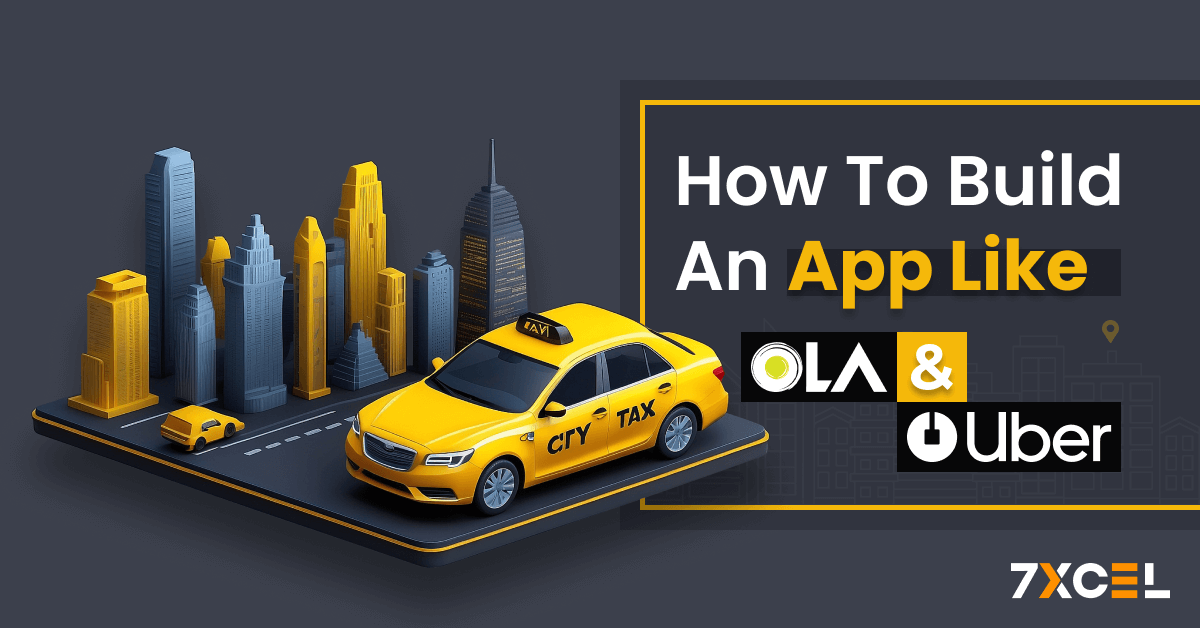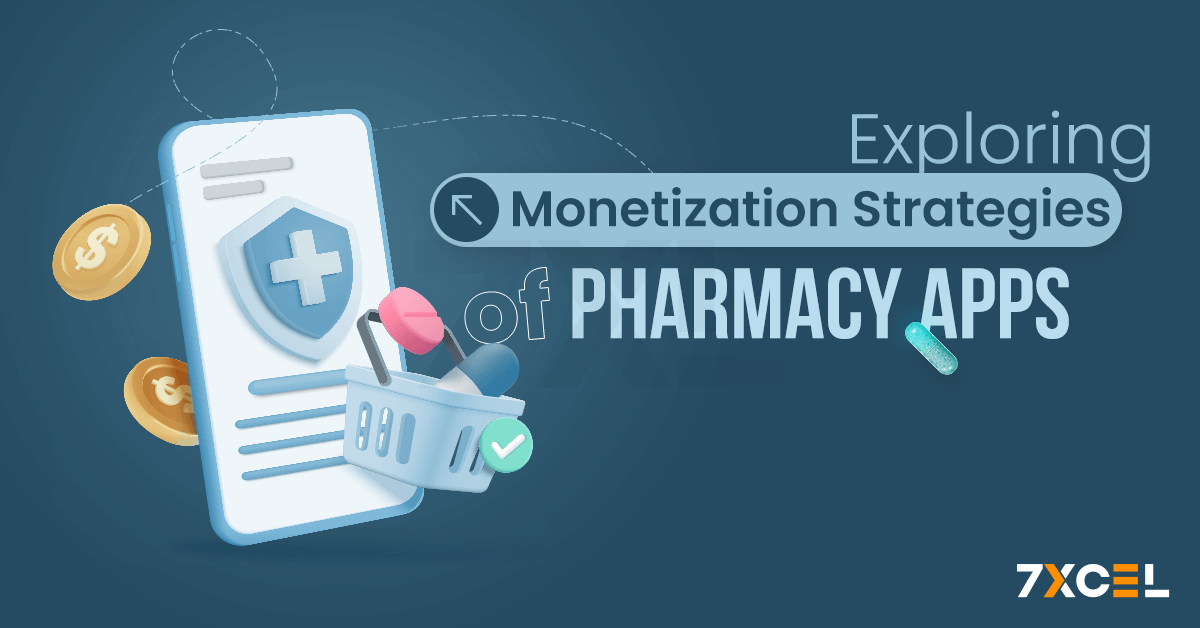Quick Summary:
Developing a ride-sharing app like Ola or Uber requires thorough market research, robust design, and continuous improvement. Focus on core features, seamless functionality, and user-friendliness to meet market demands and provide a superior user experience in the growing ride-sharing market.
In this blog, we’re going to discuss📝
- Market Overview of Ride Hailing Industry
- What Makes The Ride-Hailing Industry Exponential?
- How Ride Sharing App Works?
- How to Develop an App Like Ola/Uber?
- Key Features of a Ride-Sharing App
- How Much Does it Cost to Develop an App Like Ola or Uber?
- Tech Stack Used for Developing a Ride-Sharing App Like Ola/Uber
- Revenue Methods for a Ride-Sharing App Like Ola/Uber
In the rapidly evolving world of transportation, on-demand ride-hailing apps have revolutionized the way people travel around cities. Companies like Ola and Uber have set the benchmark for seamless, convenient, and technology-driven mobility solutions.
As an entrepreneur or a technology leader, the prospect of building an app like Ola or Uber can be both exciting and daunting. In this complete guide, we will explore the key considerations and strategies for developing a successful on-demand ride-hailing app that can compete in this dynamic market.
Market Overview of Ride Hailing Industry
The global ride-sharing market has witnessed exponential growth, driven by increasing urbanization, smartphone penetration, and the need for convenient transportation options. The success of giants like Ola and Uber underscores the potential for new entrants to capture significant market share by offering innovative solutions and superior customer experiences. Following are the stats that give the industry overview:
Market Revenue Projections:
- Expected to reach US$165.60 billion by the year 2024
- Anticipated annual growth rate (CAGR) from 2024 to 2028 is 6.83%
- Projected market volume by 2028 is US$215.70 billion
User Growth Projections:
- The number of users in the Ride-hailing market is expected to increase significantly
- Projected to reach 1.97 billion users by 2028
User Penetration Rate:
- Estimated to be 22.6% in 2024
- Expected to reach 24.6% by 2028
Average Revenue Per User (ARPU):
- Estimated to be around US$94.80
What Makes The Ride-Hailing Industry Exponential?
Due to the growing need for accessible, economical, and convenient transportation options, the on-demand ride-hailing market has grown exponentially in recent years. Ola and Uber have emerged as the dominant players in this realm, offering a wide range of services, from traditional ride-sharing to electric vehicles and food delivery. As the stats above suggests the popularity of the industry. Let’s see what factors are playing the important role in the rapidly growing taxi industry.

- Urbanization: More people are living in cities, where public transportation can be inconsistent.
- Smartphone Penetration: Increased access to smartphone has made ride-sharing apps more accessible.
- Convenience: Users prefer the ease and reliability of ride-sharing apps over traditional taxis.
This dynamic market presents a lucrative opportunity for businesses to enter the ride-sharing space with innovative and user-centric solutions.
How Ride Sharing App Works?
Ride-sharing apps revolutionize the traditional taxi service by leveraging advanced technology to offer convenient, reliable, and user-friendly transportation solutions. Here’s a detailed breakdown of how these apps function:

User Registration and Profile Creation
- Riders: Using their phone number, email address, or social network profiles, users download the app & register. They create a profile that includes personal information and payment details for a seamless experience.
- Drivers: Along with supplying the required paperwork, including their driver’s license, insurance, and car registration, drivers register on the platform. They undergo a verification process to ensure safety and compliance with the platform’s standards.
Booking a Ride
- Requesting a Ride: Riders open the app, enter their destination, and request a ride. The app uses GPS to detect their current location automatically.
- Ride Options: Users can choose from various ride options such as economy, premium, or shared rides, depending on their preference and budget.
Matching Riders and Drivers
- Driver Matching: Once a ride is requested, the app’s algorithm matches the rider with the nearest available driver. The driver receives a notification with the ride details and can choose to accept or decline the request.
- Ride Confirmation: Upon acceptance, the rider is notified with the driver’s details, including the name, vehicle information, and estimated time of arrival (ETA).
Ride Tracking and Navigation
- Real-Time Tracking: Both the rider and driver can track each other’s location in real-time using the app’s built-in GPS functionality. This ensures transparency and helps the rider monitor the driver’s approach.
- Navigation Assistance: The app provides navigation assistance to the driver, guiding them to the rider’s pickup location and then to the destination using the most efficient route.
Payment Integration
- Fare Estimation: The app estimates the fare based on the distance, duration, and type of ride selected. Riders can see the estimated fare before confirming the ride.
- Payment Processing: Once the ride is completed, the app automatically processes the payment through the rider’s preferred payment method, which could include credit/debit cards, digital wallets, or cash.
Rating and Feedback System
- Rider Feedback: After the ride, riders are prompted to rate their driver and provide feedback on their experience. This helps maintain service quality and allows other users to make informed decisions.
- Driver Feedback: Similarly, drivers can rate riders and provide feedback, which helps in identifying and addressing any issues related to rider behavior.
Customer Support and Safety Features
- In-App Support: The app offers in-app customer support for resolving issues related to bookings, payments, or any other service-related concerns.
- Safety Measures: Features like SOS buttons, ride-sharing details with trusted contacts, and driver background checks ensure the safety and security of both riders and drivers.
Admin Panel and Analytics
- Management Dashboard: The app includes an admin panel where administrators can manage users, monitor rides, process payments, and handle disputes.
- Analytics and Reporting: Advanced analytics tools provide insights into user behaviour, ride patterns, and revenue, helping the business make data-driven decisions and improve service delivery.
By integrating these components, ride-sharing apps offer a seamless and efficient transportation solution that benefits both riders and drivers. The combination of user-friendly design, real-time tracking, secure payment processing, and robust customer support ensures a superior user experience and drives the success of the platform.
How to Develop an App Like Ola/Uber?
The on-demand ride-hailing industry is booming, offering convenience, affordability, and instant gratification for riders. But with established giants like Uber and Ola, how can a new player make a mark? At 7xcel we specialize in crafting innovative mobile app solutions, and we can help you build the next disruptive force in ride-sharing. Here are some things that you need to keep in mind while develop an app like Ola/Uber.

1. Market Research and Analysis
- Understand the Market: Analyze the ride-hailing market in your target region. Study your competitors and identify gaps that your app can fill.
- Identify Your Target Audience: Determine who your users will be—commuters, travellers, or corporate clients—and understand their needs and preferences.
2. Define Your Unique Value Proposition
- Differentiation: Decide what will set your app apart from existing ride-hailing services. This could be unique features, superior customer service, lower prices, or a specific niche market.
3. Key Features to Include
- User Registration and Profiles: Simple and secure sign-up process, social media login options.
- Real-Time Tracking: GPS tracking for real-time location updates of drivers and users.
- Ride Booking: Easy interface for booking rides, scheduling, and canceling.
- Fare Estimation: Accurate fare calculation based on distance, time, and traffic conditions.
- Payment Gateway Integration: Multiple payment options including credit/debit cards, mobile wallets, and cash.
- Rating and Reviews: Feedback system for riders and drivers to rate each other.
- Notifications: SMS, email, and push notifications for ride status, promotions, and updates.
- Ride History: Detailed ride history and invoices for users.
4. Technical Stack and Development
- Choose the Right Platform: Decide whether to launch on iOS, Android, or both.
- Backend Development: Use robust backend technologies like Node.js, Python, or Ruby on Rails. Implement cloud services for scalability.
- Frontend Development: Develop a user-friendly and intuitive interface using technologies like React Native or Flutter for cross-platform compatibility.
- APIs and Integrations: Integrate essential APIs for payment gateways, map services (like Google Maps), and messaging services.
5. User Interface and Experience Design
- User-Centric Design: Ensure your app is easy to navigate and visually appealing. Prioritize user experience.
- Driver Interface: Create a separate interface for drivers with features like ride requests, earnings tracking, and navigation.
6. Testing and Quality Assurance
- Beta Testing: Conduct thorough testing with a small group of users to identify and fix bugs.
- Usability Testing: Ensure the app is easy to use and all features function as intended.
- Performance Testing: Test the app under various conditions to ensure it performs well under load.
7. Launch and Marketing
- Soft Launch: Release the app in a smaller market to gather initial user feedback and make necessary improvements.
- Full Launch: Plan a full-scale launch with marketing campaigns, press releases, and promotions.
- User Acquisition: Implement strategies to attract users, such as referral programs, discounts, and partnerships.
8. Post-Launch Maintenance and Updates
- Continuous Monitoring: Keep track of app performance and user feedback.
- Regular Updates: Roll out regular updates to fix bugs, improve features, and introduce new functionalities.
- Customer Support: Provide excellent customer support to handle user queries and issues promptly.
Developing an app like Ola or Uber requires significant planning, resources, and dedication. By following these steps, you can create a competitive and user-friendly ride-hailing app that meets the needs of your target audience.
Key Features of a Ride-Sharing App
Creating a successful ride-sharing app involves incorporating essential features that enhance user experience, ensure safety, and provide a seamless service. Here are the key Taxi App Features for Successful Taxi Business to include in a ride-sharing app:
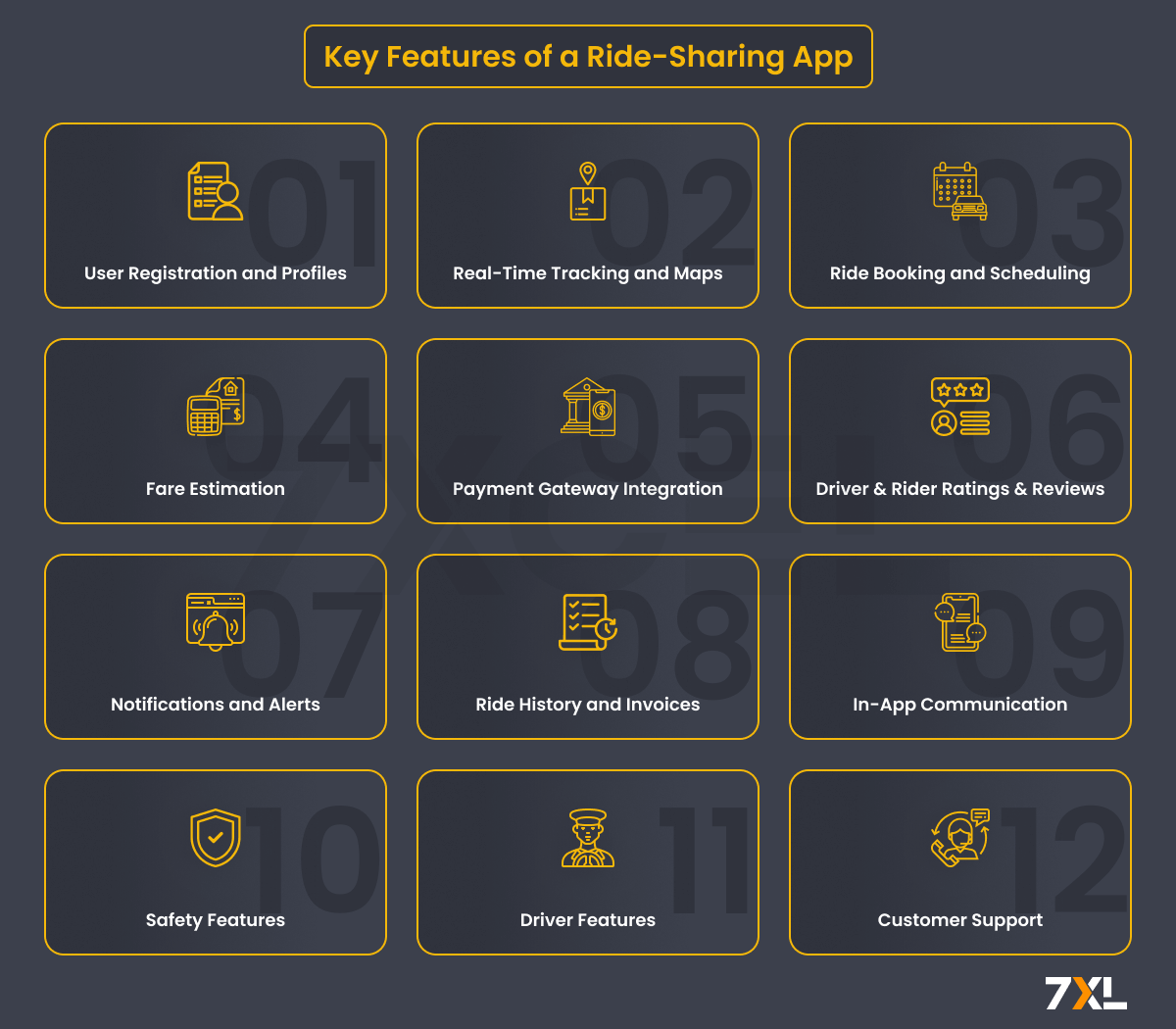
1. User Registration and Profiles
- Easy Sign-Up/Login: Allow users to sign up using their email, phone number, or social media accounts. Simplify the process to encourage quick onboarding.
- Profile Management: Users can create and manage their profiles, including personal details, payment information, and preferences.
2. Real-Time Tracking and Maps
- GPS Integration: Use GPS technology to provide real-time tracking of drivers and rides. This feature enhances safety and allows users to track their rides from start to finish.
- Route Optimization: Implement algorithms to suggest the most efficient routes, saving time and reducing costs.
3. Ride Booking and Scheduling
- Instant Booking: Allow users to book rides instantly by selecting their pick-up and drop-off locations on a map.
- Scheduled Rides: Offer the option to schedule rides for a future date and time, catering to users who plan ahead.
- Ride Matching: Match riders with the nearest available driver to minimize wait times.
4. Fare Estimation
- Accurate Fare Calculation: Provide upfront fare estimates based on distance, estimated time, traffic conditions, and surge pricing during peak hours.
- Fare Breakdown: Display a detailed breakdown of the fare, including base fare, distance fare, time fare, and any additional charges.
5. Payment Gateway Integration
- Multiple Payment Options: Support various payment methods, including credit/debit cards, mobile wallets, and cash payments.
- Secure Transactions: Ensure all transactions are secure, encrypted, and comply with relevant regulations and standards.
6. Driver and Rider Ratings and Reviews
- Feedback System: Implement a rating and review system where both riders and drivers can provide feedback on their experience.
- Quality Control: Use ratings and reviews to maintain service quality, reward high-rated drivers, and address issues with low-rated drivers.
7. Notifications and Alerts
- Real-Time Notifications: Send push notifications, SMS, or email alerts to inform users about ride status, driver arrival, payment confirmation, and promotions.
- Customizable Alerts: Allow users to customize notification preferences according to their needs.
8. Ride History and Invoices
- Ride History: Provide users with a detailed history of their past rides, including date, time, route, driver details, and fare.
- Digital Invoices: Generate and send digital invoices for each ride, which users can view and download from the app.
9. In-App Communication
- Messaging: Enable in-app messaging between riders and drivers for seamless communication without sharing personal contact details.
- Call Masking: Implement call masking to protect the privacy of users by using temporary phone numbers for communication.
10. Safety Features
- SOS Button: Include an emergency SOS button that riders can use to alert authorities or predefined contacts in case of an emergency.
- Trip Sharing: Allow riders to share their trip details with family or friends for added security.
- Driver Verification: Ensure thorough background checks and verification processes for all drivers to enhance user safety.
11. Driver Features
- Driver Dashboard: Provide drivers with a dedicated dashboard to manage ride requests, view earnings, and access navigation.
- Earnings Tracking: Allow drivers to track their daily, weekly, and monthly earnings.
- Navigation Assistance: Integrate with map services to provide turn-by-turn navigation to drivers.
12. Customer Support
- In-App Support: Offer an in-app support feature where users can get help with common issues, FAQs, and contact customer service.
- 24/7 Support: Provide round-the-clock customer support to address any urgent issues or concerns.
By incorporating these key features, you can create a comprehensive ride-sharing app that offers a smooth, secure, and user-friendly experience for both riders and drivers. This will help you build trust, retain users, and compete effectively in the ride-sharing market.
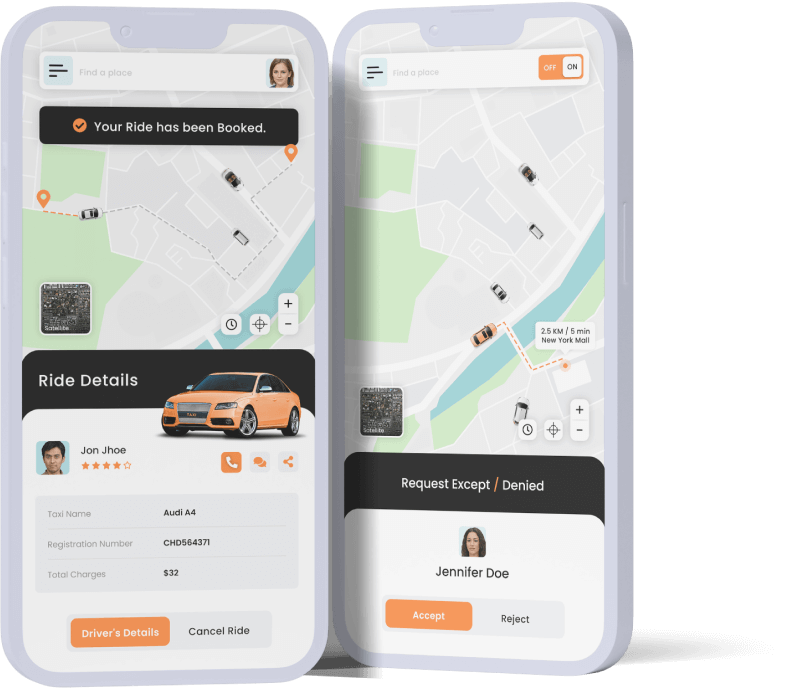
Interested to develop a standout taxi booking app?
7xcel help you build a tailored taxi app using cutting-edge techs & advanced algorithms, enhancing user experience to its fullest potential.
How Much Does it Cost to Develop an App Like Ola or Uber?
Developing an app like Ola or Uber involves various factors that influence the overall cost. These factors include the complexity of features, the development team’s location and expertise, and the technology stack used. Here’s a detailed breakdown of the cost efficient taxi booking app development components:

| Component | Cost Range (USD) |
| Planning and Research | $15,000 $35,000 |
| Market Research | $5,000 $15,000 |
| Business Analysis | $10,000 $20,000 |
| UI/UX Design | $15,000 $35,000 |
| Wireframing and Prototyping | $5,000 $10,000 |
| Visual Design | $10,000 $25,000 |
| Backend Development | $35,000 $95,000 |
| Server-Side Development | $20,000 $50,000 |
| Database Integration | $5,000 $15,000 |
| API Development | $10,000 $30,000 |
| Frontend Development | $50,000 $100,000 |
| iOS App Development | $20,000 $40,000 |
| Android App Development | $20,000 $40,000 |
| Web Development | $10,000 $20,000 |
| Key Features Integration | $60,000 $140,000 |
| Real-Time Tracking | $10,000 $20,000 |
| Payment Gateway | $10,000 $20,000 |
| Ride Matching Algorithm | $10,000 $30,000 |
| Notification System | $5,000 $15,000 |
| Rating and Review System | $5,000 $10,000 |
| In-App Communication | $10,000 $20,000 |
| Safety Features | $5,000 $15,000 |
| Testing and Quality Assurance | $25,000 $55,000 |
| Functional Testing | $10,000 $20,000 |
| Performance Testing | $5,000 $15,000 |
| Usability Testing | $5,000 $10,000 |
| Bug Fixing | $5,000 $10,000 |
| Deployment and Launch | $11,000 $35,000 |
| App Store Submission | $1,000 $5,000 |
| Marketing and Promotion | $10,000 $30,000 |
| Post-Launch Maintenance | $15,000 $35,000 annually |
| Regular Updates | $5,000 $15,000 annually |
| Customer Support | $10,000 $20,000 annually |
| Total Estimated Cost | $215,000 $495,000 |
This table summarizes the cost components and their respective ranges, providing a clear overview of the potential expenses involved in developing a ride-sharing app like Ola or Uber.
Tech Stack Used for Developing a Ride-Sharing App Like Ola/Uber
Choosing the right technology stack is crucial for the successful development of a ride-sharing app like Ola or Uber. The tech stack should ensure scalability, performance, security, and a seamless user experience. Collaborating with a specialized Taxi Booking App Development Company can help in selecting and implementing the most suitable technologies for each component of the app.
Their expertise ensures that the app is built to handle high traffic, integrate advanced features like real-time tracking and payment processing, and maintain robust security measures. Here’s a detailed breakdown of the technologies used in different components of the app:
| Component | Technology | Description |
| Frontend Development | ||
| iOS Development | Swift, Objective-C | Native languages for iOS development |
| UIKit, CoreLocation, MapKit | Frameworks for UI, location services, and maps | |
| Xcode | Integrated development environment (IDE) for iOS | |
| Android Development | Kotlin, Java | Native languages for Android development |
| Android SDK, Google Maps SDK | Frameworks for Android development and maps | |
| Android Studio | Integrated development environment (IDE) for Android | |
| Cross-Platform Development | React Native, Flutter | Frameworks for building cross-platform apps |
| JavaScript (React Native), Dart (Flutter) | Programming languages for cross-platform development | |
| Backend Development | ||
| Server-Side Languages | Node.js, Python (Django/Flask), Ruby on Rails | Backend languages and frameworks |
| Database | PostgreSQL, MySQL, MongoDB, Cassandra | Relational and NoSQL databases |
| Web Servers | Nginx, Apache | Web servers for handling HTTP requests |
| Hosting and Cloud Services | AWS, Google Cloud Platform (GCP), Microsoft Azure | Cloud platforms for hosting and scalability |
| APIs and Integrations | ||
| Maps and Geolocation | Google Maps API, Mapbox | APIs for geolocation and maps |
| Payment Gateways | Stripe, PayPal, Braintree | Payment processing services |
| Communication Services | Twilio, Firebase Cloud Messaging (FCM) | SMS, voice, video, and push notifications |
| Real-Time Communication | Socket.io, WebRTC | Real-time data and communication |
| Admin Panel and Dashboard | ||
| Web Development Frameworks | React.js, Angular, Vue.js | Frameworks for building admin panels |
| Admin Dashboard Templates | AdminLTE, Metronic | Pre-built templates for admin interfaces |
| Data Analytics and Monitoring | ||
| Analytics Tools | Google Analytics, Mixpanel | Tools for tracking user behavior and engagement |
| Monitoring Tools | New Relic, Datadog | Application performance monitoring and analytics |
| Security Measures | ||
| Authentication and Authorization | OAuth, JWT (JSON Web Tokens) | Secure authorization and authentication mechanisms |
| Data Encryption | SSL/TLS, AES | Encryption standards for secure data transmission and storage |
| Regular Security Audits | Security audits and vulnerability assessments | Regular checks to identify and mitigate security risks |
The tech stack for developing a ride-sharing app like Ola or Uber includes a mix of modern frontend and backend technologies, cloud services, APIs, and security measures. Choosing the right combination of these technologies ensures that the app is scalable, secure, and capable of providing a seamless user experience.
Revenue Methods for a Ride-Sharing App Like Ola/Uber
Developing a ride-sharing app involves not only understanding the technical aspects but also figuring out how to generate revenue effectively. Here are some common revenue methods used by ride-sharing apps like Ola and Uber:
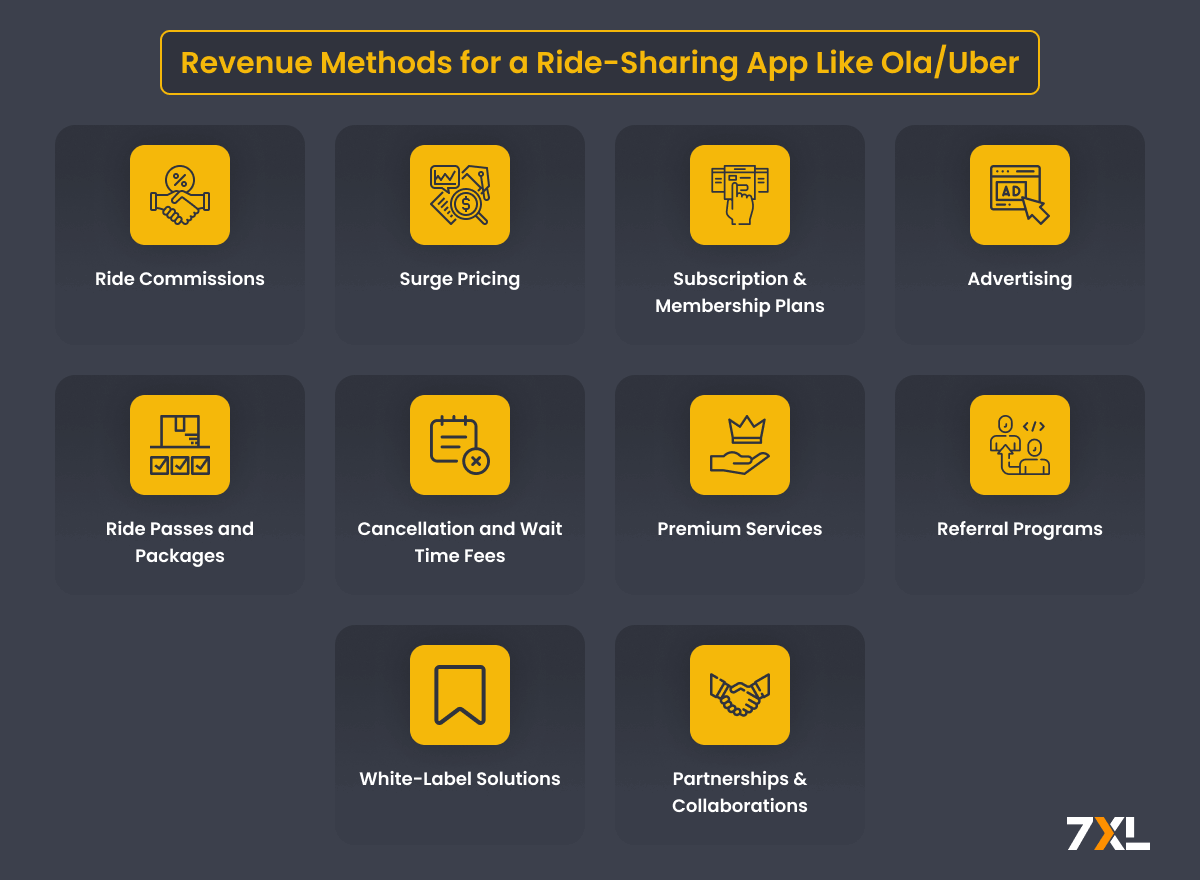
1. Ride Commissions
- Percentage-Based Commissions: The primary revenue source is taking a commission from each ride. Typically, the app charges drivers a percentage of the total fare, which can range from 15% to 30%.
- Fixed Fee per Ride: In some cases, a fixed fee might be charged per ride instead of a percentage.
2. Surge Pricing
- Dynamic Pricing: Implement surge pricing during peak hours, high demand, or bad weather conditions. This increases the fare rates, and the additional charge becomes a significant source of revenue.
- Algorithm-Driven: Utilize algorithms to determine surge pricing based on real-time demand and supply.
3. Subscription and Membership Plans
- Driver Subscriptions: Offer subscription plans for drivers with benefits like lower commission rates, priority support, and access to advanced features.
- Rider Memberships: Provide riders with subscription plans that offer benefits such as discounted rides, priority booking, and premium support.
4. Advertising
- In-App Advertising: Display ads within the app, such as banner ads, video ads, or pop-ups. These can be targeted based on user behavior and preferences.
- Partner Promotions: Collaborate with brands and local businesses to promote their products or services to your user base through in-app advertisements and special offers.
5. Ride Passes and Packages
- Bulk Ride Packages: Offer ride packages where users can purchase a set number of rides at a discounted rate. This ensures a steady cash flow and encourages users to use the app more frequently.
- Corporate Packages: Provide ride packages tailored for corporate clients, allowing businesses to manage employee transportation needs efficiently.
6. Cancellation and Wait Time Fees
- Cancellation Fees: Charge users a fee if they cancel a ride after a certain period. This compensates the driver for their time and deters users from canceling rides frequently.
- Wait Time Charges: Implement charges for the time drivers spend waiting for passengers beyond a grace period.
7. Premium Services
- Luxury and Premium Rides: Offer premium services such as luxury cars, larger vehicles for group travel, or specialized services like pet-friendly rides. These services command higher fares, increasing overall revenue.
- Scheduled Rides: Provide the option to schedule rides in advance, often at a premium price due to the added convenience.
8. Referral Programs
- User Referrals: Implement referral programs where existing users earn rewards for bringing new users to the platform. This can lead to increased user acquisition and engagement.
- Driver Referrals: Offer incentives to drivers for referring other drivers to the platform, expanding the driver base and enhancing service availability.
9. White-Label Solutions
- Licensing Technology: License your technology and app framework to other businesses or markets. This allows other companies to use your ride-sharing platform under their brand while you earn revenue from licensing fees.
10. Partnerships and Collaborations
- Partnership with Local Businesses: Partner with local businesses for special promotions or exclusive offers to your users, earning a commission from these deals.
- Collaboration with Event Organizers: Collaborate with event organizers to provide transportation solutions for events, conferences, or concerts, earning a fee for each ride booked through the partnership.
Conclusion
Revenue generation for ride-sharing apps involves a combination of direct and indirect methods. By diversifying revenue streams and continuously innovating, ride-sharing platforms can maintain profitability and sustainability in a competitive market. Implementing these revenue methods ensures that the app not only provides value to users and drivers but also achieves financial success.
